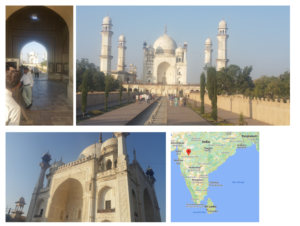While traveling in India, you’ll often hear people say, “You have to see the Taj Mahal. There’s nothing like it!” Well, with all due respect, there IS something almost exactly like it in the small Indian town of Aurangabad.
When Donica and I arrive at the Bibi Ka Maqbara, we do a major double take. Did someone, somehow, transport the entire Taj Mahal structure to this provincial town 6-hours drive east of Mumbai? You see, the Bibi Ka Maqbara is a dead ringer for its more famous brethren in Agra, (near Delhi) — from its white-domed main building to its slightly-tilted flanking towers. The resemblance is uncanny and perhaps unsurprising, considering that the architect, Ata-ullah was the son of Ustad Ahmad Lahauri, the principal designer of the Taj Mahal. It’s only as you walk around and explore the site that you start the notice the differences. The “Bibi,” for example, is quite a bit smaller than the Taj. It has a central walkway rather than a longitudinal collecting pool. Its main building isn’t embedded with semi-precious stones. Nevertheless, the building is quite beautiful in its own right, especially as the sky changes color from midday white to late-afternoon dusky red.

As the story goes, the Bibi Ka Maqbara was built in ~1668 by Prince Muhi-ud-din (later known as Aurangzeb upon his accession). Aurangzeb had married Dilras Banu Begum, a princess of the prominent Safavid dynasty of Iran (Persia), some years earlier. Dilras was the Prince’s first wife and chief consort, as well as his favorite, and they had five children together. When Dilras died from complications after giving birth to her fifth child, Aurangzeb’s pain was extreme and their eldest son, Azam Shah, promptly had a nervous breakdown. To celebrate his wife’s memory, Aurangzeb commissioned a mausoleum at Aurangabad to act as Dilras’ final resting place, known as Bibi Ka Maqbara (“Tomb of the Lady”). Aurangzeb, himself, is buried a few kilometers away from her mausoleum in nearby Khuldabad.
Having visited Agra a few times in the past, it’s hard not to compare the Bibi Ka Maqbara to the Taj Mahal as we walk around the grounds. Still, this 450-year-old mausoleum is deserving of respect. Like the Taj, it’s a monument to love and grief … a monument to a family torn apart by loss, seeking to preserve the memory of a loved one (albeit in grand fashion). It may not be as elaborate as its more-celebrated doppelganger, but the Bibi has its own class – and a LOT fewer tourists!
(When you go shopping for, let’s say, a jacket or a handbag, does it have to be a name-brand item from a famous designer? Or, can you abide by a cheaper, good quality knock off? While it’s often true that “you get what you pay for,” we can get a bit caught up in the concept of “the best or nothing at all.” Perhaps more importantly, by putting on blinders when it comes to “the best and the famous,” we can lose sight of what’s there in front of us. Enjoy the subtleties and the nuances of whatever you have or wherever you are. Chances are someone in the world would consider it a privilege to be in your shoes.)
